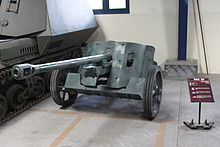5 cm PaK 38
| 5 cm PaK 38 | |
|---|---|
| General Information | |
| Military designation: | 5 cm PaK 38 |
| Manufacturer country: | German Empire |
| Developer / Manufacturer: | Rheinmetall-Borsig |
| Development year: | 1937 to 1939 |
| Production time: | 1939 to 1944 |
| Number of pieces: | 9568 |
| Weapon Category: | Anti-tank gun |
| Team: | 5 soldiers |
| Technical specifications | |
| Overall length: | 4.75 m |
| Pipe length: | 2.975 m |
| Caliber : |
5 cm |
| Caliber length : | L / 60 |
| Cadence : | 15 rounds / min |
| Elevation range: | –8 ° to +27 degrees |
| Side straightening area: | 65 ° |

The 5-cm-PaK 38 was an anti-tank gun ( PaK , PAK or Pak for short ) of the German Wehrmacht with a caliber length of L / 60, which was mainly used in direct fire fighting by the tank destroyer troops against armored combat vehicles. The equivalent to this standard weapon system as a turret cannon in armored vehicles or battle tanks was the largely identical combat vehicle cannon 5 cm KwK 39 L / 60 .
Development and production
The 5 cm PaK 38 has been developed by Rheinmetall-Borsig since 1937 and delivered to the troops since April 1940. It was the successor to the 3.7 cm PaK 36 and was later supplemented by the 7.5 cm PaK 40 . A total of around 9,568 PaK 38 were produced. The production price for 1,800 working hours was 10,600 Reichsmarks .
description
The 5 cm PaK 38 had a spreader carriage with two tubular spars and a protective shield of two armor plates, each 25 mm apart, each 4 mm thick. The ZF 3 × 8 ° telescopic sight served as the target optics . The life of a tube was approximately 4000 to 5000 shots.
ammunition
| 5 cm PaK 38 | Tank shell 39 | Panzer Grenade 40 (hard core) |
Stick grenade 42 | HE grenade |
| Weight | 2.25 kg | 0.85 kg | 13.5 kg | 1.96 kg |
| Muzzle velocity | 823 m / s | 1198 m / s | 160 m / s | 549 m / s |
| Penetration at a 30 ° angle of incidence | ||||
| from a distance of 500 m | 59 mm | 72 mm | 180 mm | |
| from a distance of 1000 m | 48 mm | 38 mm | ||
| Penetration at an angle of incidence of 60 ° | ||||
| from a distance of 0 m | 73 mm | 143 mm | ||
| from a distance of 250 m | 67 mm | 109 mm | ||
| from a distance of 500 m | 61 mm | 86 mm | 180 mm | |
| from a distance of 750 m | 56 mm | 69 mm | ||
| from a distance of 1000 m | 50 mm | 55 mm | ||
| from a distance of 1250 m | 45 mm | 44 mm | ||
| from a distance of 1500 m | 40 mm | |||
| Penetration at 90 ° angle of incidence | ||||
| from a distance of 0 m | 99 mm | 165 mm | ||
| from a distance of 250 m | 88 mm | 141 mm | ||
| from a distance of 500 m | 78 mm | 120 mm | 180 mm | |
| from a distance of 750 m | 69 mm | 101 mm | ||
| from a distance of 1000 m | 61 mm | 84 mm | ||
| from a distance of 1250 m | 53 mm | 70 mm | ||
| from a distance of 1500 m | 47 mm | |||
The fragmentation effect of the high-explosive grenade reached up to 13 meters to the side of the impact and up to 8 meters to the front.
commitment
The 5 cm PaK 38 was introduced to the Wehrmacht in late 1940. When the Germans were confronted with strong Soviet tanks in 1941, they were increasingly supplied with the 40 tank grenade with a tungsten core in order to be able to fight T-34 and KW-1 . When supplies of tungsten ran out in 1943, the 5 cm PaK 38 lost its effectiveness as an anti-tank weapon. Although it was intended to be replaced by other anti-tank guns, it remained in service until the end of the war.
literature
- Gander, Terry & Chamberlain, Peter: Enzyklopädie deutscher Waffen 1939-1945 , Motorbuch Verlag, 1st edition, Stuttgart 2005, ISBN 978-3-613-02481-6 .
Web links
Individual evidence
- ↑ Werner Haupt , anti-tank guns: 3.7 cm, 5.0 cm, 7.5 cm, 8.8 cm anti-tank guns without self-propelled guns; 1934-1945 , Podzun-Pallas Verlag, 1989, page 25, ISBN 978-3-7909-0360-7 .


